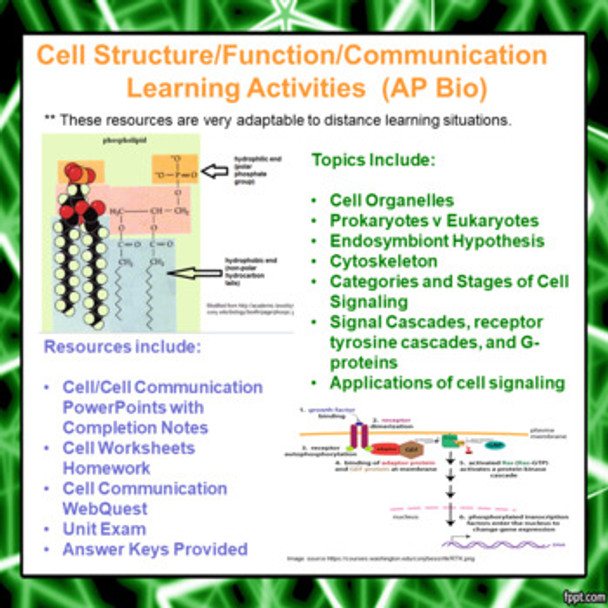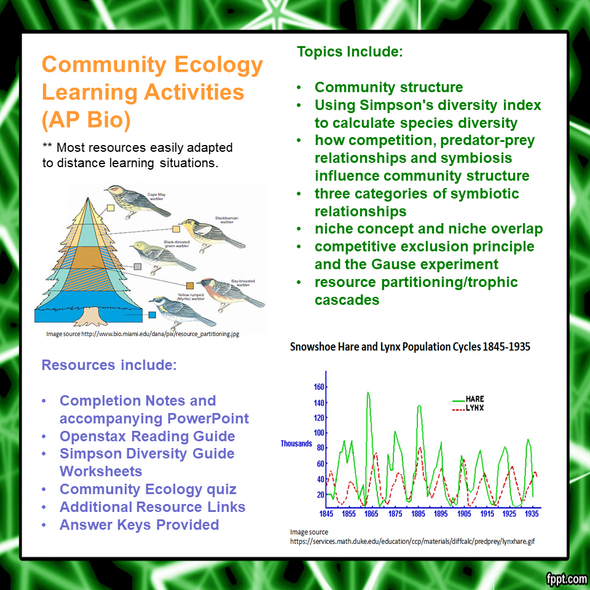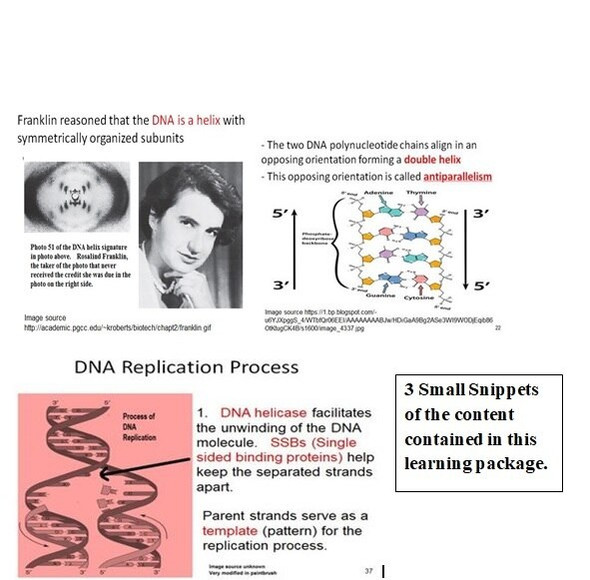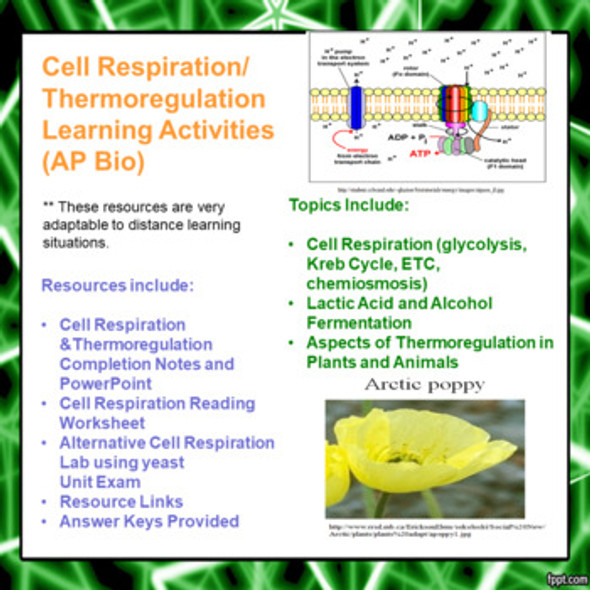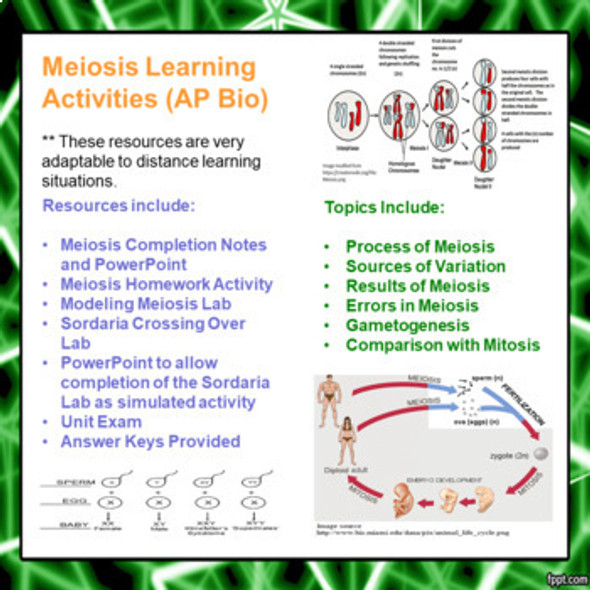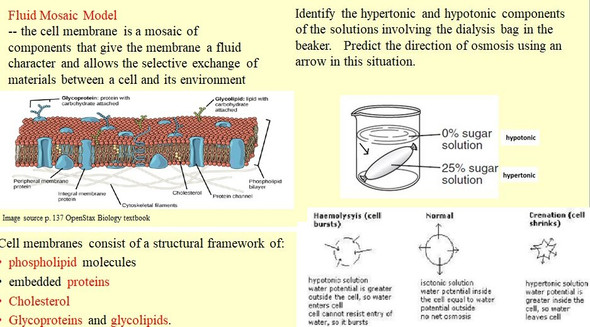Cell Structure/Function/Communication Activities for AP Biology (Distance Learning)
- Bulk Pricing:
- Buy in bulk and save
- Contributor:
- Monday's Rescue
- Grade Level:
- 9-12
- Product Type:
- Learning Package (Notes, PowerPoint, Web quest, Homework)
- File Type:
- doc, pdf, ppt
- Pages:
- 54
- Answer Key:
- Yes
Description
The zip file for this unit contains many different activities (54 pages of student handouts and 2 PowerPoint files with a total of 128 slides) which can be used to compose a unit for AP Biology or advanced Biology students involving the major topics of Cell Structure and Function and Cell Communication. Topics in this unit include cell surface area and volume considerations and calculations, introduction to the properties of the cell membrane, compartmentalization, cell organelle structure and function. as well as many aspects of cell communication. More specifics concerning the topics addressed in this package of activities appear in the objectives at the end of this description. The learning objectives and materials have been updated to meet the requirements of the 2019-2020 school year by the Educational Testing Service.
While these lessons were originally designed for my AP Biology curriculum, they can be adapted to any advanced level Biology program.
This lesson packet contains a listing of the learning goals, common core learning standards, NGSS learning standards and the AP Biology performance indicators addressed in these materials. These are included in the packet and at the end of the description of this lesson.
The components of this lesson package can easily be displayed to students using and LCD projector and may be readily modified into formats facilitating smartboard technology. Most documents are included in both word doc or docx as well as pdf format to allow editing for specific teacher needs. The learning guides/assignments contain links to online resources to support student learning.
Suggested answer keys are included for all items.
The specific contents of the learning package includes the following items (the page count for these items are actual student handouts as answer key page counts are not included):
-- Cell Structure and Function and Cell Communication Objectives and NGSS, ETS and Common Core Standards in word and pdf format (4 pages)
-- Cells PowerPoint (74 slides)
-- Cell Completion Notes to accompany the PowerPoint (11 pages) in word and pdf format
-- Cell Worksheet # 1 with key in word and pdf (includes the topics of surface area and volume calculations/considerations, compartmentalization and introduction to membrane processes) (5 pages/25 questions)
-- Cell Worksheet in word and pdf format with key (5 pages/ 32 organelle identification and 24 multiple choice questions)
-- Cell Exam (Structure and Function) with key in word and pdf format (7 pages/25 multiple choice, 7 completion and 6 short answer questions)
-- Cell Communication PowerPoint (60 slides)
-- Cell Communication Completion Notes to accompany the PowerPoint in word and pdf format (17 pages)
-- Cell Communication Project webquest with key in word and pdf format (7 pages) (all links functional as of 8-1-18)
Cell Structure and Function Learning Objectives ETS
Enduring Understanding
SYI-1 Living systems are organized in a hierarchy of structural levels that interact.
Learning Objectives
SYI-1.D Describe the structure and/ or function of subcellular components and organelles.
SYI-1.E Explain how subcellular components and organelles contribute to the function of the cell.
SYI 1.F Describe the structural features of a cell that allow organisms to capture, store, and use energy.
ENE-2.K Describe the membrane- bound structures of the eukaryotic cell.
ENE-2.L Explain how internal membranes and membrane- bound organelles contribute to compartmentalization of eukaryotic cell functions.
Enduring Understanding
IST-3 Cells communicate by generating, transmitting, receiving, and responding to chemical signals.
Learning Objectives
IST-3.A Describe the ways that cells can communicate with one another.
IST-3.B Explain how cells communicate with one another over short and long distances.
IST-3.C Describe the components of a signal transduction pathway.
IST-3.D Describe the role of components of a signal transduction pathway in producing a cellular response.
IST-3.E Describe the role of the environment in eliciting a cellular response.
IST-3.F Describe the different types of cellular responses elicited by a signal transduction pathway.
IST-3.G Explain how a change in the structure of any signaling molecule affects the activity of the signaling pathway.
Cell Structure and Function Learning Goals
Upon completion of this unit the student will be able to:
1. list several reasons that most cells must be small.
2. compute the surface area to volume ratio of any cell.
3. discuss the structure and function of the plasma membrane.
4. define the term compartmentalization and explain its importance to cell function.
5. discuss the structure and function of the following major cell structures
or organelles including the; lysosome, rough endoplasmic reticulum,
peroxisomes, smooth endoplasmic reticulum, mitochondrion, golgi complex, ribosome, nucleus, nuclear membrane, and nucleolus.
6. list three organelles found in plant cells but not animal cells and their functions.
7. discuss the chief structural differences between prokaryotic and eukaryotic cells.
8. define each of the following terms; autolysis and apoptosis.
9. discuss several features of the cytoskeleton.
10. explain the endosymbiont theory and the concept of cytoplasmic inheritance.
11. discuss how several structures hold cells together.
12. discuss some aspects of cellular communications.
Cell Communication Learning Goals
Upon completion of this unit the student will be able to:
1. Categorize chemical signals in terms of the proximity of the communication cells
2. Overview the basic elements of a signaling system of a target cell
3. Describe the nature of a ligand-receptor interaction and state how such interactions initiate a signal transduction system
4. Compare and contrast G-protein-linked receptors, tyrosine-kinase receptors, and ligand gated ion channels
5. Describe how phosphorylation propagates signal information
6. Describe how signal information is transduced into cellular responses in the cytoplasm and in the nucleus
7. Describe how signal amplification is accomplished in target cells
8. Describe how target cells discriminate among signals and how the same signal
can elicit multiple cellular responses
NGSS Standard
HS-LS1-1. Construct an explanation based on evidence for how the structure of DNA determines the structure of proteins which carry out the essential functions of life through systems of specialized cells.
Common Core State Standards Connections:
ELA/Literacy –
RST.11-12.1 Cite specific textual evidence to support analysis of science and technical texts, attending to important distinctions the author makes and to any gaps or inconsistencies in the account.
WHST.9-12.2 Write informative/explanatory texts, including the narration of historical events, scientific procedures/ experiments, or technical processes.
WHST.9-12.9 Draw evidence from informational texts to support analysis, reflection, and research.
Mathematics –
MP.4 Model with mathematics.
Terms of Use
- Purchase of the product is for classroom use by the purchaser only. It is a violation for individuals, schools, and districts to redistribute, sell, or post this item on the Internet or to other individuals.
This work is licensed under a Creative Commons Attribution-NonCommercial-ShareAlike 4.0 International License
Please feel free to browse any of the other products in my store.

